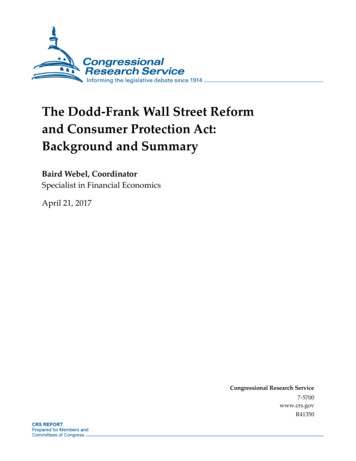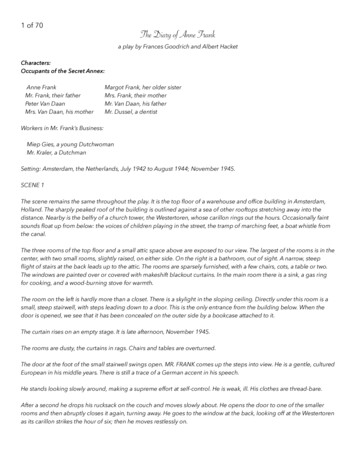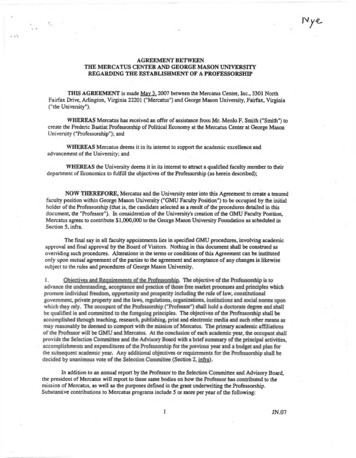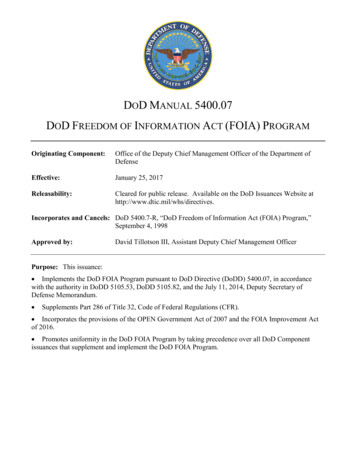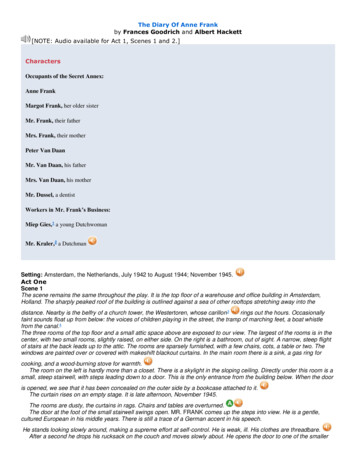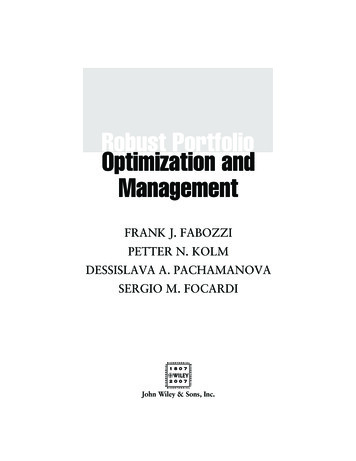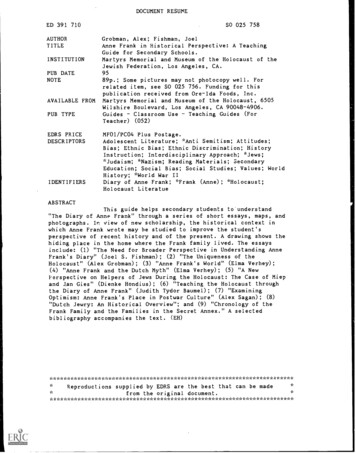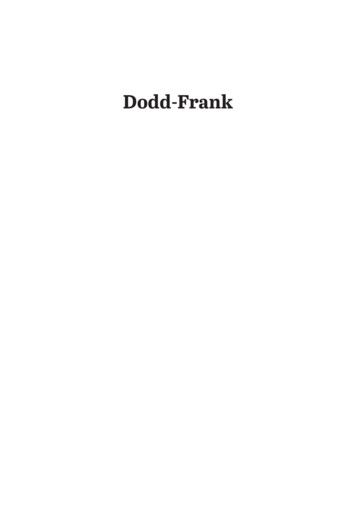
Transcription
Dodd-Frank
Dodd-FrankWhat It Does and Why It’s Flawededited by Hester Peirce and James BroughelArlington, Virginia
About the Mercatus Center at George Mason UniversityThe Mercatus Center at George Mason University is the world’s premier universitysource for market-oriented ideas—bridging the gap between academic ideas and realworld problems.A university-based research center, Mercatus advances knowledge about how marketswork to improve people’s lives by training graduate students, conducting research,and applying economics to offer solutions to society’s most pressing problems.Our mission is to generate knowledge and understanding of the institutions that affectthe freedom to prosper and to find sustainable solutions that overcome the barrierspreventing individuals from living free, prosperous, and peaceful lives.Founded in 1980, the Mercatus Center is located on George Mason University’sArlington campus.www.mercatus.orgCopyright 2012 by James Broughel, Robert W. Greene, Patrick A. McLaughlin,Hester Peirce, J. W. Verret, Lawrence J. White, and the Mercatus Center at GeorgeMason UniversityMercatus CenterGeorge Mason University3351 N. Fairfax DriveArlington, VA 22201Typeset by Sidecar Studio, Harrisonburg, Virginia. Composed in Veronika Burian andJosé Scaglione’s Abril.Library of Congress Cataloging-in-Publication DataDodd-Frank : what it does and why it's flawed / edited by Hester Peirceand James Broughel.pages cm.Includes index.ISBN 978-0-9836077-7-9 (pbk.) -- ISBN 978-0-9836077-8-6 (e-book)1. United States. Dodd-Frank Wall Street Reform and Consumer ProtectionAct. 2. Financial services industry--Law and legislation--United States.3. Financial institutions--Law and legislation--United States. I.Peirce, Hester, editor. II. Broughel, James, 1981- editor.KF969.58201.A2 2013346.73'082--dc232012051429First published, December 2012Printed in the United States of America
ContentsIntroduction11by Hester Peirce and James BroughelAbbreviations19Part I: A Title-by-Title Look at Dodd-Frank23by Hester PeirceTitle I: Financial Stability25Title II: Resolution35Title III: Ending the Office of Thrift Supervision45Title IV: Hedge Funds53Title V: Insurance61Title VI: New Authority for the Fed67Title VII: Derivatives77Title VIII: Systemically Important Utilities and Activities91Title IX: Securities and Exchange Commission99Title X: Consumer Financial Protection Bureau111Title XI: Fed Transparency and Bailouts121by James BroughelTitle XII: Government Grant Programs135Title XIII: Recouping Costs of Government Programs141Title XIV: Mortgages145Title XV: Requirements for Nonfinancial Companies153Title XVI: Taxing Derivatives163
Part II: Perspectives on Dodd-FrankDodd-Frank: The Good and the Not-So-Good167169by Lawrence J. WhiteA Missed Opportunity: The Paulson Plan as an183Alternative Framework to Dodd-Frankby J. W. VerretQuantifying and Projecting Dodd-Frank’s Restrictions193by Patrick A. McLaughlin and Robert W. GreeneConclusion203by Hester Peirce and James BroughelFurther Reading205About the Authors2076
“In the economic sphere an act, a habit, aninstitution, a law produces not only one effect,but a series of effects. Of these effects, the firstalone is immediate; it appears simultaneouslywith its cause; it is seen. The other effectsemerge only subsequently; they are not seen;we are fortunate if we foresee them.”—Frédéric Bastiat, “What Is Seen and Not Seen” (1850)“One of the great mistakes is to judgepolicies and programs by their intentionsrather than their results.”—Milton Friedman, in a 1975 interview with Richard Heffner onThe Open Mind
Introductionby Hester Peirce and James BroughelIt has been more than five years since the financial crisis beganand more than two years since the passage of the legislativeresponse, the Dodd-Frank Wall Street Reform and ConsumerProtection Act ( Dodd-Frank ).1 The nature and magnitude of theeffects of the largest piece of financial legislation in generations willbecome clearer as regulators exercise the broad discretion giventhem under the act. Regulators’ efforts at implementation are farfrom complete, with many of the rules still unwritten and othersnot yet in effect. Regardless of how the rules are written, the act willcertainly have far-reaching effects on the financial system and oureconomy. This book takes the opportunity to look at Dodd-Frank asit is being implemented and asks whether it is an effective responseto the financial crisis that so deeply rattled our nation.As is typical of crisis legislation, Dodd-Frank included many provisions crafted in haste and many other provisions drafted before the crisis for which the act provided a convenient legislative vehicle. Even asthe law was being passed, its proponents acknowledged its imperfections.2 In the years since the law’s passage, the fundamental flaws withthe legislation have become more evident.3 Dodd-Frank not only failedeffectively and holistically to respond to the crisis, but it also gives riseto a whole new set of problems that could overshadow the act’s goodelements and lay the groundwork for a future financial crisis.
IntroductionMany of the provisions in Dodd-Frank are entirely unrelated tothe crisis. Title IV, which requires hedge-fund registration, and TitleXV, which imposes a number of miscellaneous disclosure provisionson public companies, illustrate this phenomenon. Another exampleis the “Durbin amendment” in Title X, which sets price controls onfees banks can charge merchants in connection with debit cards.Other provisions, while purportedly solutions to real problemsthat emerged in the crisis, could serve to exacerbate those problems. As one example, Lawrence J. White explains in his essay inpart II how Title IX’s regulatory regime for credit rating agencies willdecrease competition and thus solidify the market share of the largest credit rating agencies.The most striking omission of the act was its failure even toattempt to reform the broken housing-finance system in the UnitedStates. The legislation ignored Fannie Mae and Freddie Mac, theflawed government-sponsored mortgage giants at the heart of thehousing crisis. White explains the gravity of this omission and Congress’s continuing failure to act with respect to housing-financereform. The failure to act is not for want of workable solutions,4 butis a result of the interest special-interest groups have in maintainingthe status quo.Dodd-Frank’s proponents portray it as a solution to the too-bigto-fail problem that led to the massive bailouts during the financialcrisis. A closer look at Dodd-Frank suggests that it not only failedto solve the too-big-to fail problem, but it also institutionalized theproblem. One of Dodd-Frank’s new bureaucracies, the Financial Stability Oversight Council ( FSOC ), has new power to designate firms“systemically important,” a phrase even experts on macroprudential regulation have trouble defining in an agreed-upon way.5 Whitepoints out that these designated firms will receive special regulatorytreatment. As the Title I section describes, the additional regulatory burden will be accompanied by an unspoken commitment that12
Introductionregulators will step in to save designated firms and their creditors ifthere is trouble. This implicit government guarantee carries a perverse incentive for large firms to take on more risk and a decreasedincentive for large firms’ shareholders and counterparties to penalize them for doing so.Also contributing to the institutionalization of too-big-to-failis the concentration of risk that emerges from Dodd-Frank. As theTitle VII section discusses, derivatives clearinghouses after DoddFrank will form a new set of large, interconnected, critically important financial entities. Likewise, the government’s involvement inthe mortgage market has grown after the financial crisis, and DoddFrank’s securitization reforms solidify the continued dominance oftaxpayer-supported housing finance.The companion of Dodd-Frank’s entrenchment of big financialcompanies is its adverse effect on small ones. With its numerous andincomprehensible complexities, Dodd-Frank gives big banks a competitive edge over their smaller rivals, who are less able to hire thelawyers and compliance personnel necessary to advise on complyingwith the law in the most cost-effective manner. The effects on smallbanks may be one of the most profound unintended consequences ofa law designed to rein in big banks, but only time will tell.Dodd-Frank creates a regulatory system that suppresses marketdiscipline in favor of regulatory expertise and broad regulatory authority. Congress left key decisions to regulators; it afforded them tremendous discretion to define the limits of their own authority and placesunrealistic expectations upon them.6 The underlying assumption thatregulators can effectively micromanage the market is flawed.7 Givingregulators more levers to pull and buttons to push with respect to thefinancial system only creates a false sense of security.The irony of expanding the role of regulators in the aftermath ofa financial crisis in which regulators were complicit is heightened bythe fact that even failed regulators were given new powers. With the13
Introductionexception of the Office of Thrift Supervision, which was eliminated,regulators were not held accountable for regulatory failures but wererewarded with new powers. The sections on Titles I, VIII, and IX, forexample, discuss some of the new powers given to the Securities andExchange Commission ( SEC ) and to the Federal Reserve ( Fed ), bothof which failed quite dramatically in their oversight roles the lasttime around. In the case of the Fed, as the Title XI section details,Dodd-Frank introduced some new transparency and accountabilitymechanisms for its future bailout programs. Nevertheless, questionsremain about the adequacy of these reforms.To make matters worse, Dodd-Frank gives some of these regulators a free hand, with few meaningful accountability checks, to intervene in the economy as they please. For example, Title II authorizesthe Federal Deposit Insurance Corporation ( FDIC ) to take over andliquidate companies, and Title X creates the remarkably unaccountable Consumer Financial Protection Bureau ( CFPB ) within the Fed.The CFPB is one of the powerful new bureaucracies created byDodd-Frank. The FSOC and the Office of Financial Research ( OFR )are two other new Dodd-Frank agencies. As the sections on TitlesI and X discuss, these agencies are shielded from accountability toCongress, the president, and the American people.So much of the decision making was left to regulators that the fullimplications of the law may not be known for years. The implementation process is not keeping pace with statutory requirements, andmany deadlines have been missed.8 Implementing the vague concepts laid out in Dodd-Frank is not an easy task, as the Volcker Rulediscussion in White’s essay and the Title VI section illustrate. MostDodd-Frank rules are being crafted without the benefit of thorougheconomic analysis.9 The rulemaking gaps and absence of economicanalysis mean market participants and regulators remain uncertainabout how Dodd-Frank will work in practice. As one example, regulators only recently defined a derivative, though that definition is14
Introductioncentral to all of the derivatives reforms in Title VII of the act.10Adverse consequences for consumers are already coming to light.As is often the case, measures intended to protect consumers can endup harming them. Given Dodd-Frank’s breadth, these consequencesrange from possible threats to privacy, as discussed in the Title I section, to decreased consumer choice and increased consumer costs,as discussed in the Title X and XIV sections. The Title XIV sectionprovides an example of a troubling trend in regulatory policy—theidea that government knows better than consumers what is best forthem. Government officials have taken on the paternalistic role ofsafely steering citizens toward “better” or “safer” products and services. As a consequence, consumers increasingly will face a one-sizefits-all market that costs more and offers fewer choices.Another less obvious ramification of Dodd-Frank is that it distracts regulators from their core missions. The Title IV section discusses this phenomenon in the context of the SEC’s new hedge-fundauthorities. Likewise, the Commodity Futures Trading Commission ( CFTC ), newly preoccupied with regulating systemic risk,11 hasfound it difficult to devote adequate time to handling the recent failures of two CFTC-regulated firms that resulted in substantial retailcustomer losses.Many of the consequences of Dodd-Frank remain to be seen,but as McLaughlin and Greene demonstrate in their essay in Part II,Dodd-Frank already has had a measurable effect. Using the contentof the regulatory text itself as a data source, they quantify the numberof new restrictions generated by Dodd-Frank rules in 2010 and 2011.If the new Dodd-Frank rules create restrictions at the same rate, theauthors estimate that Dodd-Frank will cause a 26 percent increase inthe number of restrictions in the financial market regulation titles ofthe Code of Federal Regulations.Often it is suggested that although Dodd-Frank has its problems, no other solutions were being proposed at the time. As J. W.15
IntroductionVerret demonstrates in his essay in part II, there were other ideasfor remaking the financial regulatory system. Verret discusses then–Treasury Secretary Henry Paulson’s blueprint for financial reform,which came out in early 2008. Although that plan also had weaknesses, some of the suggested reforms proved prescient, such as recommended mortgage-market reforms. The blueprint recommendedmerging the CFTC and the SEC, agencies with considerable regulatory overlap. Dodd-Frank not only fails to implement this idea, but,as the Title VII section illustrates, it also gives the agencies redundantrule-writing tasks related to derivatives. Verret shows that althoughthe Paulson plan was not perfect, its existence demonstrates thatalternative paths for financial reform could have been considered.This book is not intended to provide a comprehensive summaryof Dodd-Frank, but rather it seeks to offer a closer look at some of itsprovisions in an effort to seriously assess its efficacy. Looking behindthe act’s celebrated objectives shows that it not only fails to achievemany of its stated goals, but it also reinforces dangerous regulatorypathologies that became evident during the last crisis and createsnew pathologies that could lay the groundwork for the next crisis.Not es1. Dodd-Frank Wall Street Reform and Consumer Protection Act, Public Law 111-203,U.S. Statutes at Large 124 ( 2010 ), 1376.2. See, for example, Jim Kuhnhenn, “Congress Approves Sweeping Reforms,” Bloomberg BusinessWeek, July 15, 2010, 38O1.htm. The article quotes Senator Dodd shortly after the passageof the bill, saying, “It is not a perfect bill, I will be the first to admit that. . . . Itwill take the next economic crisis, as certainly it will come, to determine whetheror not the provisions of this bill will actually provide this generation or the nextgeneration of regulators with the tools necessary to minimize the effects of thatcrisis.”3. See, for example, “Dodd-Frank’s Financial Outsourcing,” Wall Street Journal,16
IntroductionNovember 6, 2012. The editorial notes that Dodd-Frank “is producing an amazingtrifecta: anger among our international trading partners, a less prosperous financial market at home, and a larger taxpayer safety net.”4. See, for example, Lawrence J. White, “The Way Forward: U.S. Residential–Mortgage Finance in a Post-GSE World,” in House of Cards: Reforming America’s Housing Finance System, ed. Satya Thallam ( Arlington, VA: Mercatus Center at GeorgeMason University, March 2012 ), 67, http://mercatus.org/publication/house-cards.5. See David VanHoose, “Systemic Risks and Macroprudential Regulation: A Critical Appraisal” ( Networks Financial Institute Policy Brief 2011-PB-04, IndianaState University, Terre Haute, IN, April 2011 ), http://papers.ssrn.com/sol3/papers.cfm?abstract id 1816476&download yes.6. Senator Ted Kaufman, who voted for the legislation, made this point: “Congresslargely has decided instead to punt decisions to the regulators, saddling them witha mountain of rule-makings and studies.” Quoted in Jim Kuhnhenn, “CongressApproves Sweeping Reforms.”7. Hayek warned of the impossibility of any “single brain” mastering the informationnecessary to run a market and cautioned against efforts to micromanage “the market and similar social structures”:The recognition of the insuperable limits to his knowledge ought indeedto teach the student of society a lesson of humility which should guardhim against becoming an accomplice in men’s fatal striving to controlsociety—a striving which makes him not only a tyrant over his fellows,but which may well make him the destroyer of a civilization which nobrain has designed but which has grown from the free efforts of millionsof individuals.Friedrich August von Hayek, “The Pretence of Knowledge” ( Nobel Prize lecture,Royal Swedish Academy of Sciences, Stockholm, Sweden, December 11, 1974 ),http://www.nobelprize.org/nobel .8. As of November 1, 2012, of the 237 rulemaking deadlines that had passed, 61percent had been missed. Davis Polk, “Dodd-Frank Progress Report,” 2Dodd.Frank.Progress.Report.pdf.9. Committee on Capital Markets Regulation ( CCMR ), “CCMR Warns That InadequateCost-Benefit Analysis Opens Dodd-Frank Rulemaking to Challenge and Delay,”news release, March 7, 2012, http://capmktsreg.org/pdfs/2012.03.07 CBA let17
Introductionter.pdf. A letter to several congressional committee members is included in therelease. It reports results of an analysis of 192 Dodd-Frank rulemakings, the vastmajority of which were conducted without thorough cost-benefit analysis. Seealso Hester Peirce, “Economic Analysis by Federal Financial Regulators” ( workingpaper 12-131, Mercatus Center at George Mason University, Arlington, VA, October2012 ), egulators Peirce v1-0 1.pdf.10. Commodity Futures Trading Commission ( CFTC ) and SEC, “Further Definitionof ‘Swap,’ ‘Security-Based Swap,’ and ‘Security-Based Swap Agreement’; MixedSwaps; Security-Based Swap Agreement Recordkeeping,” Notice of Final Rulemaking, Federal Register 77 ( August 13, 2012 ).11. According to the CFTC’s website, the CFTC’s new “mission is to protect marketusers and the public from fraud, manipulation, abusive practices and systemic riskrelated to derivatives, and to foster open, competitive, and financially sound markets.” See CFTC, “Missions and Responsibilities,” index.htm.18
AbbreviationsCFPBConsumer Financial Protection BureauCFTCCommodity Futures Trading CommissionCFRCPFFDIFCode of Federal RegulationsCommercial Paper Funding FacilityDeposit Insurance FundDRCDemocratic Republic of the CongoE&Sexaminable and supervisableFDICFedFederal Deposit Insurance CorporationFederal ReserveFHAFederal Housing AdministrationFHFAFederal Housing Finance AgencyFIOFOIAFRAFSOCFederal Insurance OfficeFreedom of Information ActFederal Reserve ActFinancial Stability Oversight CouncilGAOGovernment Accountability OfficeGSEgovernment-sponsored enterpriseHUDDepartment of Housing and Urban l loan companyMBSMSRBNRSROmortgage-backed securitiesMunicipal Securities Rulemaking Boardnationally recognized statistical rating organizationOCCOffice of the Comptroller of the CurrencyOFROffice of Financial ResearchOLAOrderly Liquidation AuthorityOTCover-the-counterOTSOffice of Thrift SupervisionPWGPresident’s Working GroupQRMQualified Residential Mortgage
AbbreviationsRFCReconstruction Finance CorporationSDRSwap-Data RepositorySECSecurities and Exchange CommissionSEFSwap Execution FacilitySIFIsystemically important financial institutionTALFTerm Asset-Backed Securities Loan FacilityTARPTroubled Asset Relief ProgramUSAIDUnited States Agency for International Development20
Part IA Title-by-Title Look atDodd-Frankby Hester PeirceThe country suffered a terrible financial crisis. It started in 2007, andits reverberations continue to affect the real economy and financialsector five years later. Dodd-Frank was the legislative response to thatcrisis. This chapter provides a window into each title of Dodd-Frankin an effort to assess whether its provisions support the claim that theact provides a solution to the problems that led to the financial crisis.Too often the purported solutions threaten to become the source of newproblems in the financial sector, consumer pocketbooks, and the economy as a whole.
What Title I does:Title I establishes the Financial Stability Oversight Council( FSOC ), a multiregulator systemic-risk council.It establishes the Office of Financial Research ( OFR ), anoffice to collect, disseminate, and study financial data.It identifies systemically important financial institutionsfor special regulation by the Federal Reserve ( Fed ).It requires regulators to impose enhanced capitalrequirements and leverage limits.Why Title I’s approach is flawed:FSOC has not played an effective coordinating role in the crucialinitial years of regulatory implementation of Dodd-Frank.Designating specific firms as systemically importantcreates a market expectation that designated firms aretoo big to fail and thus dulls market discipline.The Fed’s bank-centric regulatory model will not work for nonbanks.The structure of the OFR enables it to operate withoutthe accountability expected to apply to governmentagencies and without adequate safeguards on data.
Title IFinancial StabilityTitle I of Dodd-Frank is intended to enhance financial stability. To achieve this end, it establishes two new governmententities, the Financial Stability Oversight Council ( FSOC )and the Office of Financial Research ( OFR ). Although each agency hasa commendable mission at first glance, each is fundamentally flawed.The FSOC is a multiregulator council intended to take a broadview of the financial system and identify emerging systemic risks.1It brings the nation’s financial regulators together to identify andrespond to risks to the financial stability of the United States. AsTreasury Secretary Timothy Geithner has acknowledged implicitly,however, that mission is somewhat futile. He warned that “we cannotpredict the precise threats that may face the financial system”2 andcautioned that “you won’t be able to make a judgment about what’ssystemic and what’s not until you know the nature of the shock.”3Worse than being ineffective, the FSOC could have harmful effectson the financial system.4The FSOC has struggled to fulfill even some of the more concretetasks Dodd-Frank assigned. For example, one of its statutory mandates is facilitating coordination among member agencies. A lack ofcoordination has marked the Dodd-Frank implementation process,perhaps illustrated most dramatically by the Commodity FuturesTrading Commission ( CFTC ) decision to issue its own Volcker Ruleproposal months after the other financial regulators responsible for
A Title-by-Title Look at Dodd-Frankthe rule issued a joint proposal.5 The FSOC has failed to think abouthow the package of regulations being implemented by the differentregulators works together and the aggregate costs and benefits it willgenerate. This lack of coordination has added a layer of complexity toan already complex Dodd-Frank rulemaking process. The FSOC hasnot used its authority to play a valuable coordinating role.6One of the key Dodd-Frank mandates for the FSOC is the identification of nonbank financial companies that are systemically important and require special oversight by the Federal Reserve ( Fed ). TheFSOC is currently in the process of determining which companiesshould be designated.7 In considering whether a company qualifies,Dodd-Frank tells the FSOC to consider whether material financialdistress at the company or the nature, scope, size, scale, concentration, or mix of the company’s activities could pose a threat to thefinancial stability of the United States.Singling out a group of entities in this manner directly conflictswith one of the statutory purposes of the FSOC: “To promote marketdiscipline, by eliminating expectations on the part of shareholders,creditors, and counterparties of [large, interconnected] companiesthat the Government will shield them from losses in the event of failure.”8 Companies designated by the FSOC will be perceived as too bigto fail.9 Shareholders, creditors, and counterparties will assume thatthe government will step in if there is a problem at one of these entities and, accordingly, will exercise less due diligence of their own.The resulting diminution of scrutiny by other market participantswill make it easier for a firm to take risks for which it is undercompensated and unhedged and to engage in destabilizing activities.Shareholders, creditors, and taxpayers could be exposed to greaterlosses than they would have been exposed to if market participantsmonitored firms more closely.Dodd-Frank tries to compensate for this diminished marketdiscipline by relying on more stringent regulation. Entities26
Title Idesignated by the FSOC will be subject to an additional layer ofregulation by the Fed, including more stringent capital requirements and leverage limits.10 For example, designated nonbankfinancial companies and large bank holding companies have to submit resolution plans to the Fed and the Federal Deposit InsuranceCorporation ( FDIC ), are subject—along with their subsidiaries—to examination by the Fed, may be forced to divest certain assets,have to obtain preapproval for certain acquisitions, will be subjectto enhanced prudential standards ( including graduated risk-basedcapital requirements, liquidity requirements, and concentrationlimits ), and may be subject to remediation requirements in theevent of financial distress.11As we saw in the last crisis, regulators often miss problems atthe companies they regulate. The task of overseeing nonbank financial companies takes the Fed outside its area of expertise, which hascentered on banks and bank holding companies. The requirementsimposed on nonbank financial companies are likely to be ill-suitedto their unique characteristics. Existing regulators may pay lessattention to the subsidiaries they regulate, with the expectation thatthe Fed is regulating the whole company.12 Under the Dodd-Frankregime, regulatory failures could be more likely than before.If a designated firm runs into trouble, the Fed, in order to protect its own reputation, will have an incentive to prevent the firm’sproblems from becoming publicly known. A firm’s failure ( or rumorsof its potential failure ) to pay its creditors or counterparties wouldreflect badly on the Fed as a regulator. As a consequence, regulatorscan be expected to intervene to keep these companies afloat.13 Thesecompanies will be perceived as better credit risks than other companies, and their cost of funding will be lower. Normal market processes by which firms come and go over time will be impeded.The fact that many companies have argued against designationreflects an uncertainty about the costs the new regulatory structure27
A Title-by-Title Look at Dodd-Frankwill impose and a fear of the up-front costs.14 Initial costs undoubtedly will be high as the new regulatory structure is developed andtailored for nonbank financial companies. Dodd-Frank gives designated firms a chance to challenge the designation, and some firmslikely will avail themselves of this option.A firm that is designated and then successfully challenges thedesignation in court would be able to avoid the extra regulatory costswhile still enjoying the market’s recognition that regulators thinkthe firm is too big to fail. A successful challenge will be hard giventhe short window of time ( 30 days after designation ) for mounting achallenge and the fact that judicial review is limited to considerationof whether the final determination was arbitrary and capricious.15Nevertheless, the possibility of obtaining the aura of a designationwithout the concomitant costs of additional regulation will makechallenges likely.The second new entity created by Dodd-Frank is the OFR, themission of which is to assist the FSOC and its member agencies. TheOFR might play a useful role in helping to standardize data collections by the federal financial regulators and helping to eliminateduplicative reporting. The legislative mandate and structure of theOFR, however, enables it to operate without the meaningful accountability that we expect to apply to government agencies.Although the OFR is an office within the Treasury, it enjoys nearlycomplete autonomy. Its single director is nominated by the presidentand confirmed by the Senate.16 The director has a six-year term, andDodd-Frank does not give the president any grounds for removinghim. The director must report annually to Congress on the activitiesof the OFR but is not otherwise accountable to Congress.After consulting with the Treasury secretary,17 the directordetermines the OFR’s budget, which is funded by an assessmenton large bank holding companies and nonbank financial companies supervised by the Fed.18 The OFR possesses subpoena power to28
Title Iobtain data from financial companies. The OFR’s mandate to assistthe FSOC in carrying out its systemic-oversight functions makes itlikely that the OFR will seek to collect a broad array of
with the law in the most cost-effective manner. The effects on small banks may be one of the most profound unintended consequences of a law designed to rein in big banks, but only time will tell. Dodd-Frank creates a regulatory system that suppresses market discipline in favor of regulatory expertise and broad regulatory author-ity.
